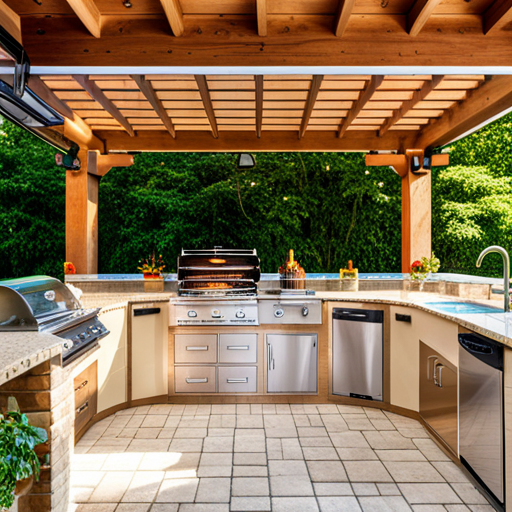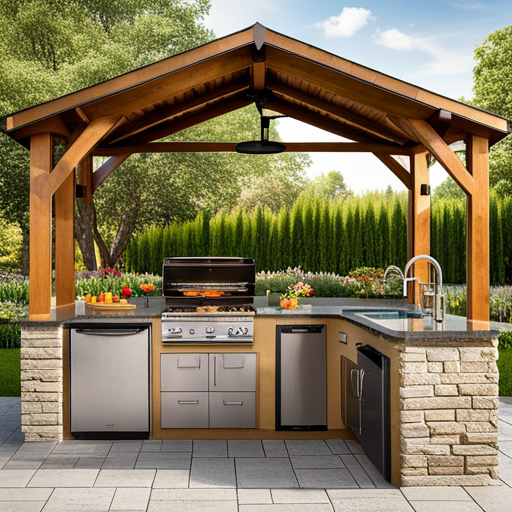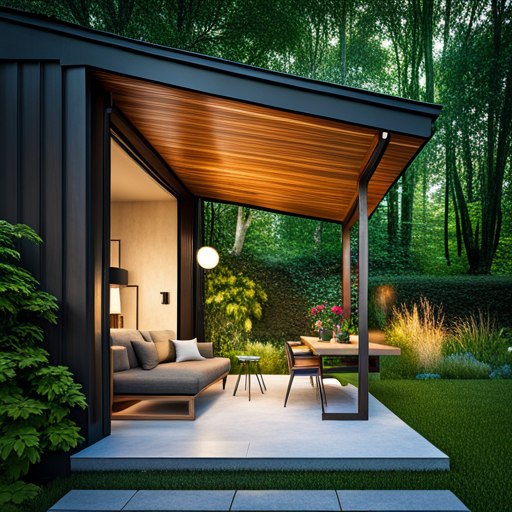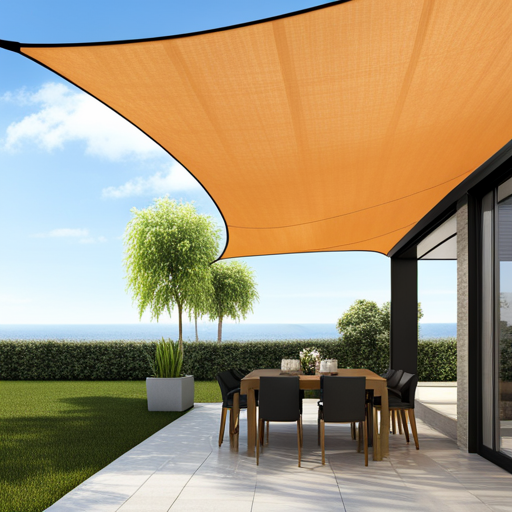Last Updated on June 19, 2024 by John Coleman

If you purchase through links on this site, we may earn a small commission. See our affiliate disclosure
Introduction
Are you an outdoor cooking enthusiast? If so, you understand that a top-notch range hood
is more than just a luxury—it’s an absolute necessity. Whether you’re sizzling up a mouthwatering feast for a family gathering or whipping up a simple meal on a balmy summer evening, having the perfect outdoor range hood can truly elevate your BBQ experience. In this guide, we’ll take you on a journey through the key factors to consider when selecting the ideal outdoor range hood for your BBQ setup. Get ready to enhance your grilling game like never before!
What is An Outdoor Range Hood for Your BBQ?
An outdoor range hood for your BBQ is a ventilation system specifically designed for use in an outdoor setting, such as a patio or backyard kitchen. Its main purpose is to remove smoke, grease, and other cooking byproducts from the air, ensuring a clean and comfortable space for your outdoor cooking adventures. Outdoor range hoods come in various sizes and styles, ranging from sleek and modern to rugged and utilitarian, depending on your personal aesthetic preference. These hoods typically feature powerful fans and filters that work together to capture and eliminate cooking odors, grease, and smoke before they have a chance to linger in your outdoor space.
Why Should I Buy An Outdoor Range Hood?
Before we dive in, let’s talk about the importance of a high-quality outdoor range hood. When cooking outdoors, smoke and grease from your BBQ can quickly become overwhelming, creating an unpleasant environment. A proper outdoor range hood for your grill effectively captures and expels these byproducts, keeping the air clean and comfortable. It also helps prevent fire hazards by removing excess heat and smoke. Plus, a range hood adds a stylish touch to your outdoor kitchen. Pretty cool, huh?
Factors to Consider When Choosing an Outdoor Range Hood
Types of Vent/Range Hood Mounts
There are three basic types of range hood mounts, each designed for different spaces and cooking needs. Let’s take a look at each one.
Wall-mounted hoods are attached directly to the wall above your BBQ grill or cooking area. These types of hoods are great for larger outdoor kitchens with plenty of space.
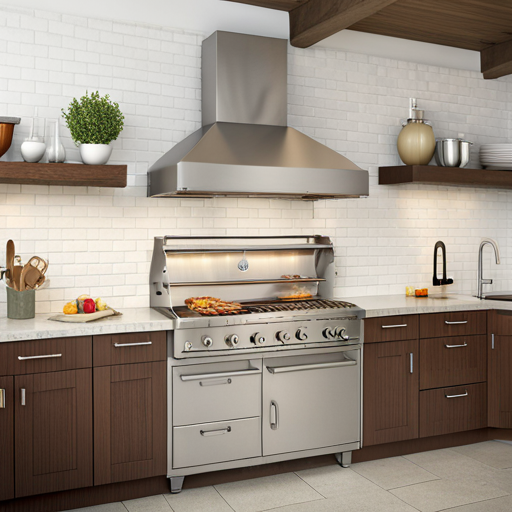
Under-cabinet hoods are mounted under an overhead cabinet, making them ideal for smaller outdoor spaces where wall space may be limited.
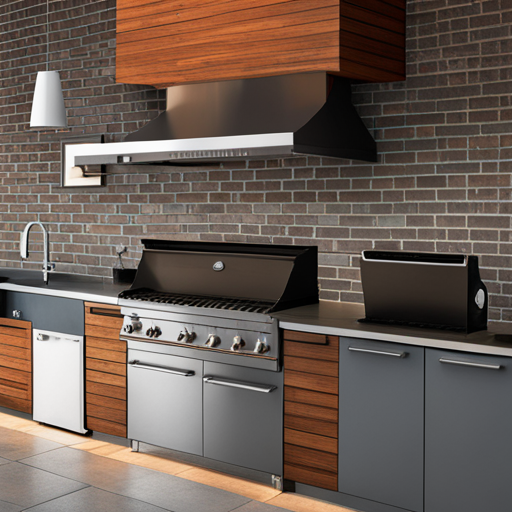
Island hoods are mounted to the ceiling above a cooking island or peninsula, providing ventilation for open-concept outdoor kitchens.

Size and Installation Space
Measure your grill or cooking area and ensure the hood is wide enough to cover it completely. A good rule of thumb is to choose a range hood that is at least 12 in. larger than your range. This would give a total of 6 in. hood overhang on each side of your range or grill. A hood that’s too small won’t effectively capture smoke and grease. Additionally, make sure you have enough space for installation, taking into account the hood’s depth and any required clearance from combustible materials.
Mounting Height
The distance between your hood and the grill directly affects its performance. I would recommend mounting the range hood between 36″- 42″ above the range. This is close enough to the range to control the amount of smoke and oil that gets released into your cooking area but also a safe distance that will prevent any excessive heat or steam from damaging the hood.
Ventilation Power CFM (Cubic Foot per Minute)
This measurement indicates how much air the range hood can move. The ventilation power
of outdoor range hoods can vary significantly from model to model so it is important to pay close attention before you purchase. A powerful hood (with a high CFM) will be more effective at removing smoke and odors but will also be noisier. An effective way to measure what CFM and select the appropriate CFM for your area is to divide the total number of BTUs your grill/range produces by 100. For instance, if your grill is rated for 100,000 BTUs, you will need a vent hood with a ventilation power of 1,000 CFM. Generally, if it is for an outdoor kitchen or cooking area, it would be beneficial to go with a little higher CFM than this formula produces. It’s better to have more and not need it than to have less and need more.
Types of Filters
Outdoor range hood filters come in three types:
- Baffle Filters – (Recommended) efficient at capturing grease and smoke but require regular cleaning. They allow for better airflow compared to other types of filters.
- Mesh Filters – constructed with layers of mesh metal that trap grease while allowing air to pass through. Mesh filters are less efficient than baffle filters but are easier to clean.
- Hybrid Filters – combine the best of both worlds with a layer of mesh over a layer of baffles. These types of filters need to be cleaned regularly as well.
Exhausting Options
- Ducted – vent air outside. Ducted models are more efficient but require more complex installation. Ductless models are easier to install but require frequent maintenance and filter replacements. It is recommended that you opt for a ducted hood if possible.
- Ductless – recirculate air indoors after filtering. If installing a ducted model is not feasible in your kitchen or outdoor area, there are some effective ductless options available on the market as well.
Duct Size
If you choose a ducted hood, make sure the duct size matches the manufacturer’s recommendations for optimal performance. Typically, a 10″ duct will accommodate any CFM (unless the duct is longer than 100′ which will need a larger diameter). If you have space constraints or other limiting factors, then the diameter of the duct should correlate to the CFM of the range hood and will range from 4″-10″ in diameter.
Type of Duct Cover
Duct covers hide the ductwork for aesthetic purposes. The basic two types are:
- Wall-mounted – These are attached to the wall and will cover your ducting as it runs up towards the ceiling. They can be adjusted in length for different ceiling heights and can come in a variety of styles such as stainless steel or tempered glass.
- Ceiling-mounted – These are mounted on the ceiling and can also be adjusted in length for different ceiling heights. They come in similar styles as the wall-mounted covers but may also have a built-in light fixture.
Material Durability
Outdoor range hoods must withstand weather elements, so choose a model made from durable materials like stainless steel. Specific grades of stainless steel recommended are 304 stainless steel (most durable) and 430 stainless steel. Also, look for features like powder coating, which adds an extra layer of protection against rust and corrosion. You may also want to consider a hood with a UV filter to protect against fading from the sun’s rays.
Price Range
Budget is a significant factor. Remember that while high-end models may offer more features, many affordable range hoods also perform well. The price range for an outdoor range hood can vary anywhere from $900-$5,000 (not including the cost of installation) while some high-end brands and models can cost even more. The cost of hiring someone to install your vent hood can vary anywhere from $150 – $2,000. It all depends on the type of range hood being installed. If a lot of cutting through walls, ceilings, or the roof is required, it will be more expensive. If you possess advanced DIY skills, it shouldn’t be too difficult for you to install yourself. Just be sure that you are comfortable with your skill set before attempting this project. If you are uncomfortable with performing the installation, it is always better to hire a professional. This will give you peace of mind and help you avoid unnecessary costs of fixing any mishaps resulting from your attempt.
Design Aesthetics
When it comes to your outdoor kitchen, the design of your range hood needs to complement its style. You’ll find a wide range of finishes and designs to choose from, whether you prefer a sleek modern look or a rustic traditional vibe. And here’s the best part – some range hoods even offer customizable options, so you can pick the perfect color and appearance that suits your outdoor space. When selecting a hood, consider the size and layout of your outdoor kitchen. You want it to fit in seamlessly without overcrowding or overwhelming the space. After all, you want the overall design aesthetic to flow effortlessly.
Noise Level
Powerful range hoods can get quite noisy, but don’t worry! If noise is a concern for you, look for models with noise-reduction features. Some range hoods even come with sound-absorbing insulation to significantly lower noise levels. Also, when choosing the location for your hood in your outdoor space, consider any seating or gathering areas nearby. You wouldn’t want a loud and intrusive range hood to disrupt conversations or ruin the peaceful ambiance of your outdoor oasis.
Maintenance and Cleaning
Some range hoods require more maintenance than others. Consider factors like filter type, ease of disassembly for cleaning, and whether or not the hood has an indicator for filter replacement. Regular cleaning and maintenance of your range hood not only keeps it looking its best but also ensures proper functioning. Proper ventilation is crucial for a safe and enjoyable outdoor cooking experience, so don’t neglect the upkeep of your range hood.
Additional Features
In addition to its primary function of removing smoke and odors from your outdoor kitchen, some range hoods offer additional features that make them even more convenient and efficient. These can include built-in lighting, variable speed controls, and even Bluetooth connectivity for remote control and monitoring. Consider which features would benefit you and enhance your outdoor cooking experience before making a final decision on a range hood.
Common Challenges and Mistakes to Avoid
Choosing the wrong size for the cooking area
Ensure the hood fully covers your grill or cooking area for effective smoke and grease capture. If the hood is too small, it won’t be able to properly remove smoke and odors, while a hood that is too large may overpower your outdoor space.
Improper installation
Improper installation can lead to issues with ventilation and performance. It’s important to follow manufacturer instructions carefully or hire a professional for installation to avoid any potential problems.
Ignoring ventilation power needs
A hood with insufficient CFM won’t clear smoke and odors effectively. Consider your cooking habits and grill size when choosing CFM. Generally you need to have a minimum of 100 CFM for every 10 inches of grill space. Another way to figure the CFM needed is to take the max number of BTUs your grill produces and divide by 100. This will give you the amount of ventilation power (CFM) you need. Either formula will work.
Forgetting to clean and maintain regularly
As mentioned before, regular cleaning and maintenance are crucial for the proper functioning of your range hood. Neglecting this can lead to a buildup of grease and debris, which can affect ventilation and potentially become a fire hazard. It’s recommended to clean the hood and filter at least every 3-6 months, depending on usage.
Not considering noise levels when choosing a model
Noise can be a nuisance, especially during prolonged cooking sessions. Check the hood’s noise level (measured in sones or decibels) before buying. If noise is a concern, look for hoods with lower sones or decibel levels.
Conclusion
Choosing the right outdoor range hood for BBQ is critical for anyone who loves grilling. Not only does it keep your outdoor kitchen clean and smoke-free, but it also contributes to a safer and more comfortable cooking environment. With the information in this guide, you’ll be well-equipped to make an informed decision and enjoy a seamless BBQ experience.
Frequently Asked Questions
Can any range hood be used outside?
No, not all range hoods are suitable for outdoor use. Make sure to check the manufacturer’s specifications and choose a hood specifically designed for outdoor use.
Would a recirculating range hood work outside?
Recirculating range hoods are not recommended for outdoor use as they do not effectively remove smoke and odors. It’s best to choose a vented hood that expels the air outside.
What is the difference between an indoor range hood and an outdoor range hood?
Outdoor range hoods are built to withstand the elements and have higher CFM ratings to effectively remove smoke and odors. They also have more durable materials and may come with additional features such as heat lamps for added convenience.
Do I need a range hood for my outdoor kitchen?
It’s not mandatory to have a range hood for your outdoor kitchen, but it is highly recommended. It will improve ventilation, reduce smoke and odors, and provide a more enjoyable cooking experience.
What are the benefits of using an outdoor range hood?
Outdoor range hoods improve air quality by removing smoke and cooking odors. They also help prevent grease buildup on outdoor surfaces and protect against potential fire hazards.
Can outdoor range hoods be used with different cooking appliances?
Many outdoor range hoods are versatile and can be used with various cooking appliances such as grills, smokers, and outdoor cooktops. Check the product specifications for compatibility.
What safety features should I look for in an outdoor range hood?
Look for features such as heat sensors, which automatically adjust fan speed based on cooking heat, and auto shut-off functions to enhance safety during use.
See Also:
A Guide to Design a Low-Budget DIY Outdoor Kitchen
How to Choose a Grill for Your Outdoor Kitchen: The Ultimate Buying Guide
If you purchase through links on this site, we may earn a small commission. See our affiliate disclosure.


